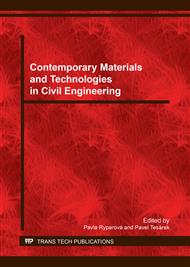p.1
p.10
p.15
p.23
p.29
p.37
p.43
p.49
Alternative Additives for Improving the Functional Characteristics and Performance-Based Behavior of Asphalt Mixes in the Fine-Grained Active Filler Form
Abstract:
Deterioration of asphalt pavements by water immersion and increased moisture content, presents one of the principal issues for pavement technologists. Especially if concentrating on initial phases of the life-cycle of a pavement. Water in the form of rain precipitation and natural air moisture can be harmful to the bonds between bitumen and aggregate particles, which occurs through the medium deteriorated adhesion on the interface of those phases, or the overall deterioration of the adhesion. Even if it might look at the first glance that bituminous binder creates perfectly impermeable layer of particular aggregate particles, in reality the bitumen film makes unstable coating of aggregates in unequal thicknesses and frequencies. Those weakened areas are far more susceptible to water and moisture affects, which enter the asphalt layer on the boundary of aggregates and bituminous binder. To improve the adhesion between bitumen and aggregates and to get in general better functional characteristics of asphalt mixtures large number of available additives exists in civil engineering. First group can be defined as additives which are added directly to the bituminous binder and provides a kind of bitumen modification. Second group includes mineral additives, which may partially or completely replaced fine-grained particles, normally in the form of filler. In this article the objective was set to qualify effect of mechanically activated microfiller originating from limestone by-products or from recycled concrete as a substitute to fine-grained active filler in asphalt mixtures. The research targeted to utilize waste materials and to contribute to the reduction of overall negative impacts to the environment.
Info:
Periodical:
Pages:
1-9
Citation:
Online since:
March 2017
Authors:
Price:
Сopyright:
© 2017 Trans Tech Publications Ltd. All Rights Reserved
Share:
Citation:


